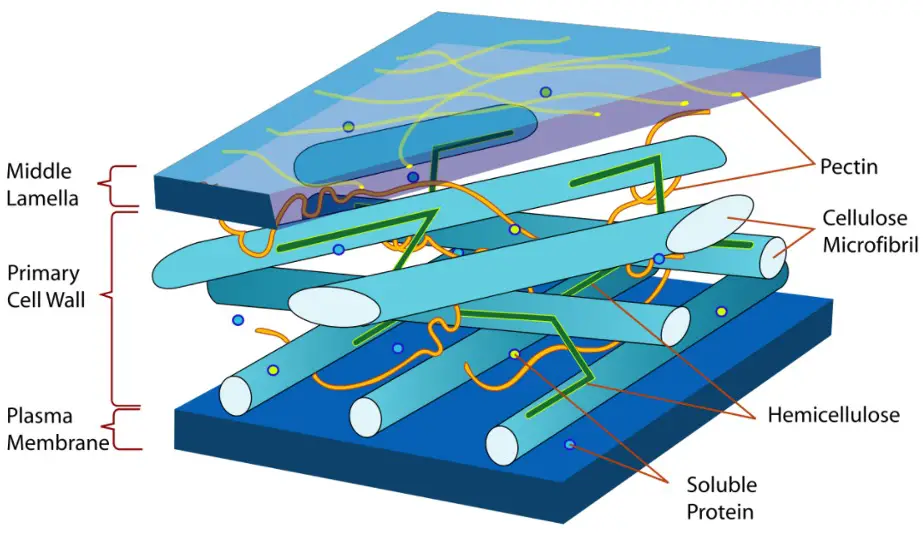Table of Contents
Middle Lamella Definition
Middle Lamella is an intercellular substance rich in pectin that binds neighboring cells together.
What is Middle Lamella?
Apart from the other cytoplasmic structures and organelles, a plant cell is a membrane-bound structure with a cell wall, plastids (particularly chloroplasts), and a big vacuole (e.g. nucleus, mitochondria, endoplasmic reticulum, and Golgi apparatus). Plant cells, like animal cells, have a cell membrane that covers the protoplasm and protects it from the outside world. Plant cells, on the other hand, vary from animal cells in that they have a cell wall that sits on top of the cell membrane.

Plants, on the other hand, aren’t the only ones who have cell walls. Algae, fungi, and the majority of prokaryotes also have cell walls. In terms of structure and chemistry, the cell wall of plants differs from the cell wall of these organisms.
The cell wall in plant cells is made up of two layers: the primary cell wall, which is a thin, flexible, and extensible layer made up of cellulose, pectin, and hemicellulose, and therefore the storage cell wall, which seems to be a thick layer rich in lignin that strengthens and waterproofs the wall and is made inside the first cell membrane that has stopped expanding in surface arches. A middle lamella, a pectin-rich intercellular substance that binds neighboring cells together, lies between the major walls.
Plants rely on their cell walls to help them resist osmotic pressure. The cell wall of bacteria is made up of peptidoglycan, which is necessary for many bacteria to survive. Gram-positive and Gram-negative bacteria are distinguished by the structure of their cell walls. Gram-positive bacteria have a thick cell membrane that’s made from several layers of peptidoglycan and teichoic acids. Gram-negative bacteria have a cell wall that is relatively thin, with only a few layers of peptidoglycan.
Except for a gaggle of methanogens, archaea have cell walls that are made from glycoprotein S-layers, pseudopeptidoglycan, or polysaccharides instead of peptidoglycan. The cell wall of fungus is made up of chitin and other polysaccharides, whereas the cell wall of algae is made up of glycoproteins and polysaccharides, and in some algal species, silicic acid.
Middle Lamella Features
Cell walls in plants are divided into three categories: primary cell wall, secondary cell wall, and middle lamella. The middle lamella is the outermost layer of the cell wall in between cells. It’s high in pectin, which binds adjacent cells’ main cell walls together. It stabilizes the cells and forms plasmodesmata between them. It’s also the first layer to form during cytokinesis, especially from the cell plate that splits the two cells during cell division. Calcium and magnesium pectates are found within the middle lamella.
Middle Lamella Function
The plant cell’s cell wall shields it from mechanical stress. The cell membrane offers strength, rigidity, and protection to plant cells, particularly against osmotic lysis. The middle lamella is a portion of the cell wall that connects neighboring cells. It also helps cells communicate with one another by creating plasmodesmata between them.
Middle Lamella Citations
- Metabolism of polysaccharides in dynamic middle lamellae during cotton fibre development. Planta . 2019 May;249(5):1565-1581.
- The Middle Lamella of Plant Fibers Used as Composite Reinforcement: Investigation by Atomic Force Microscopy. Molecules . 2020 Feb 1;25(3):632.
- The middle lamella-more than a glue. Phys Biol . 2017 Feb 16;14(1):015004.
- Figures are created with BioRender.com







